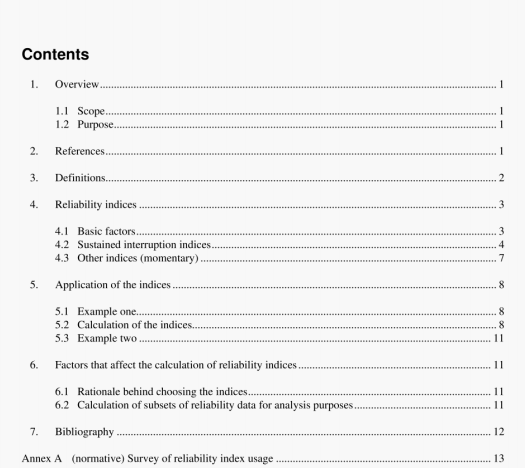IEEE Std 1366:2001 pdf free download.IEEE Guide for Electric Power Distribution Reliability Indices.
3.13 major event: A catastrophic event that exceeds design limits of the electric power system and that ischaracterized by the following (as defined by the utility):
a)Extensive damage to the electric power system;
b)More than a specified percentage of customers simultaneously out of service;c)Service restoration times longer than specified.
Some examples are extreme weather, such as a one in five year event, or earthquakes.
3.14 momentary event interruption:An interruption of duration limited to the period required to restoreservice by an interrupting device.Note: Such switching operations must be completed in a specified time notto exceed 5 min. This definition includes all reclosing operations that occur within 5 min of the first interrup-tion. For example, if a recloser or breaker operates two, three, or four times and then holds, the event shall beconsidered one momentary interruption event.
3.15 momentary interruption: Single operation of an interrupting device that results in a voltage zero.Forexample, two breaker or recloser operations equals two momentary interruptions.
3.16 outage (electric power systems): The state of a component when it is not available to perform itsintended function due to some event directly associated with that component. Notes: 1.An outage may ormay not cause an interruption of service to customers, depending on system configuration.2.This definitionderives from transmission and distribution applications and does not apply to generation outages.
3.17 reporting period: A period assumed to be one year unless otherwise stated.
3.18 scheduled interruption (electric power systems): A loss of electric power that results when acomponent is deliberately taken out of service at a selected time, usually for the purposes of construction,preventative maintenance, or repair.Notes: 1.This derives from transmission and distribution applicationsand does not apply to generation interruptions. 2.The key test to determine if an interruption should be clas-sified as a forced or scheduled interruption is as follows. If it is possible to defer the interruption when suchdeferment is desirable,the interruption is a scheduled interruption; otherwise,the interruption is a forcedinterruption. Deferring an interruption may be desirable,for example,to prevent overload of facilities orinterruption of service to customers.
3.19 step restoration: The restoration of service to blocks of customers in an area until the entire area orfeeder is restored.
3.20 sustained interruption: Any interruption not classified as a momentary event.Any interruption longerthan 5 min.
3.21 total number of customers served: The total number of customers served on the last day of the report-ing period.If a different customer total is used, it must be clearly defined within the report.
IEEE Std 1366:2001 pdf free download
